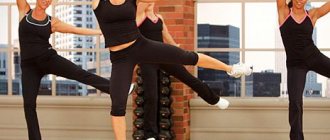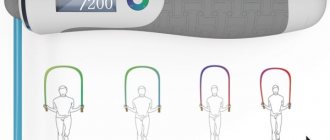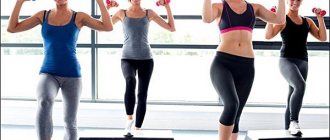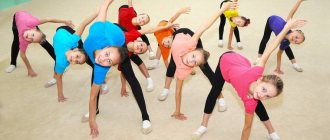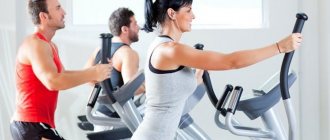As is usually the case, having decided to take a closer look at their health and start an active lifestyle, people are often faced with the problem of choice: today, fitness centers and sports complexes offer a huge number of different opportunities - from well-equipped gyms to large swimming pools.
Moreover, each type of physical activity (be it athletics, bodybuilding, or fitness) solves a specific problem, performs a specific task (fat burning, maintaining muscle tone, body shaping, etc.).
Aerobics is a set of gymnastic exercises performed to rhythmic music. And it is this type of exercise that is one of the most popular among people seeking to maintain a healthy lifestyle.
What is aerobics
Aerobic exercise is a great way not only to tone the body, but also to ensure the flow of oxygen to all organs and systems of the body.
Unlike fitness, where a certain strength load takes place, all aerobic exercises are quite simple and do not require special training, so even a person who has never played sports can easily endure a workout.
Aerobics classes include several basic elements:
- Working out all muscle groups of the body;
- Breathing exercises;
- Work on developing flexibility and plasticity.
The difference between aerobics and anaerobic exercise is the way energy is produced:
- During strength (anaerobic) training, glucose undergoes breakdown, resulting in the formation of a large number of lactic acid molecules, which are responsible for the growth of muscle mass, as well as ATP (adenosine triphosphoric acid) molecules, the main source of energy. A lot of lactic acid is released, but little ATP. As a result, there is an active process of muscle growth, while there is not enough energy for long-term strength activity (in bodybuilding, short periods of intense muscle work are practiced, followed by rest). During strength training, the body prefers to produce energy from carbohydrates.
- During aerobic exercise, the breakdown of glucose occurs with the participation of oxygen. Such training is characterized by a much lower intensity than strength training, so primarily fats are used as “fuel”. Saturating the body with oxygen allows you to exercise for 45-60 minutes without rest.
For greater clarity, we suggest studying the summary table:
| Aerobic exercise | Anaerobic exercise | |
| primary goal |
|
|
| Glucose breakdown | Occurs with the participation of oxygen. It takes a certain time to deliver oxygen to the cells (usually at least 20 minutes), so glycolysis proceeds more slowly, which requires increasing the duration of the session. | It occurs without the participation of oxygen, so lactic acid begins to be released almost immediately after the start of the workout, ensuring the rapid breakdown of carbohydrates. |
| Intensity | Medium – increase in heart rate to 60-80% of the maximum permissible norm (pulse on average 120-160 beats per minute) | High – increase in heart rate to a level of 80% or higher of the maximum permissible norm (pulse on average 170-190 beats per minute) |
| Duration of training | From 45 minutes and above (maximum – 1.5 hours). Active fat burning begins no earlier than 30 minutes after the start of the workout. | From 30 to 45 minutes. After this period, the body becomes exhausted (including oxygen starvation of the brain), which prolongs the recovery process and makes training ineffective. |
| Energy release | ATP molecules are formed in large quantities, which provides endurance and allows you to actively engage in 45-60 minutes. | Few ATP molecules are formed, so you can’t exercise for more than 45 minutes. |
It is worth noting that currently most sports programs are “hybrid” - athletes actively combine aerobic and anaerobic exercise to achieve the most effective results. For example, in aerobics, after 10-15 minutes of cardio exercise, a small 5-minute strength set follows - an exercise with large weights (dumbbells, barbells, training on machines).
The benefit of aerobics is that, in addition to burning fat, during exercise there is increased ventilation of the lungs and, as a result, activation of the heart.
What are the benefits of aerobics?
Like any type of physical activity, aerobics brings great benefits to our body
:
- Heart training
. The heart muscle, like other muscles, needs constant support, especially since the health of our body largely depends on it. It’s not for nothing that aerobics is called a cardio exercise - during exercise, not only the muscles of the musculoskeletal system are actively trained, but also the heart (as a result, blood circulation improves, and the organs receive the maximum amount of nutrients). - Lung training
. During aerobic exercise, the volume of “consumed” air increases significantly. This is achieved through the right combination of motor and breathing exercises. As a result, all organs and systems of the body receive a sufficient amount of oxygen necessary for proper metabolism. - Training all muscle groups
. During aerobic exercise, almost all muscles work, which ensures they are constantly maintained in sufficient tone. A tangible advantage of aerobics is that due to the active enrichment of cells with oxygen, there is practically no increase in muscle mass (lactic acid is not produced), therefore, it is impossible to “pump up” while doing aerobics. - Stimulation of the gastrointestinal tract
. The activity of the abdominal muscles well stimulates the functioning of the stomach and intestines, which will ensure the absence of intestinal disorders, constipation, flatulence, etc.
In addition, there are a huge number of benefits of aerobics specifically for losing weight and figure:
- Active burning of subcutaneous fat
. During active cardio training, it is fat cells, not carbohydrates, that are used as an energy source, while a slight increase in muscle mass occurs.
Don’t be afraid if after 2-3 weeks of aerobics (provided you follow your diet), the number on the scales has not decreased at all, or maybe even on the contrary – it has become higher. The fact is that fat cells have less mass than muscle cells, so with a significant decrease in body volume (due to fat burning), weight can remain at the same level.
- Improving body contour
. The absence of excess weight is not always the main condition for a beautiful figure. Thin people who neglect physical activity experience sagging muscles and skin, which does not add beauty to their figure. Regular aerobic training will help you easily maintain normal weight and also provide your muscles with good tone and relief.
Among other things, aerobic exercise provides a comprehensive health effect:
- Improving endurance indicators.
- Improved posture.
- Prevention of cardiovascular diseases.
- Training of the vestibular apparatus (development of a sense of balance, coordination of movements).
- Reducing blood pressure by activating the work of the heart muscle, increasing the size and number of capillaries.
- Normalization of metabolism in the body.
- Improving the psychological state, preventing stress, resting after serious mental activity, normalizing sleep, etc.
An important advantage of aerobic training is its low intensity, making this type of physical activity suitable for everyone, regardless of age, gender, body type and physical fitness. At the same time, it is women who most often attend classes:
- Aerobics is a fairly easy way to get rid of a couple of extra pounds and make your figure attractive and graceful.
- This is an excellent option for preventing breast cancer, as well as good rehabilitation assistance for people who have undergone surgery to remove a tumor.
- Cardio training is an excellent opportunity to absolutely safely strengthen the pelvic muscles, which will be very useful during pregnancy and childbirth, and will also help to avoid congestion in the pelvic organs.
The benefits of aerobics for the body as a whole are very significant - it is not for nothing that this type of activity (along with swimming) is recommended for people who have undergone surgery and need to restore vitality.
Indications for aerobic training
Aerobics is not just one of the popular sports. Aerobic training is often recommended by doctors as therapeutic exercise for people in need of recovery from injuries and illnesses. Medical indications for aerobics include the following:
- Restoration of the body after long-term illnesses, especially if bed rest has been observed for a long time.
- Rehabilitation after injuries, fractures or operations. During this period, it is important to ensure minimal load.
- Lack of regular physical activity, sedentary work.
- Constant feeling of fatigue, sleep disturbance, stress, tendency to depression, irritability.
- Overweight and obesity (training intensity is determined based on the severity of the problem).
- Prevention of certain diseases (diabetes mellitus, heart attacks and strokes).
Aerobic exercise is an excellent way to strengthen the immune system, so it is recommended for people who are often sick and have difficulty withstanding infectious viral diseases.
Contraindications to aerobic exercise
Despite the fact that aerobics brings a lot of benefits and has a general health-improving effect, before starting exercises, it is necessary to obtain a comprehensive consultation with a doctor. However, there are a number of contraindications to attending training:
- Early period of rehabilitation after serious operations and injuries (surgical interventions, fractures, sprains, etc.). It is recommended to begin active restoration of motor activity no earlier than after 1.5-2 months.
- Diseases of the cardiovascular system (heart failure, tachycardia), blood diseases.
- Chronic diseases in the acute stage.
- Infectious viral diseases.
- Diseases of the musculoskeletal system, osteochondrosis.
- Phlebeurysm.
If you neglect the recommendations of doctors, then aerobics will do more harm than good. In addition, do not forget about control over the intensity of your training: do not try to surpass yourself - in no case should you work “to exhaustion”.
Step aerobics fat burning workout
Step aerobics helps you lose weight by melting subcutaneous fat. Almost all existing types of exercises in step aerobics are designed for this main task. It also carries out preventive actions for diseases of the musculoskeletal system (helps get rid of arthritis and prevent osteoporosis). This type of activity puts a powerful strain on the legs; in addition, according to experts, an hour-long step aerobics session is compared to a 12-kilometer run.
Women of any age can attend step aerobics. In order for the activity to take place with maximum efficiency, it is advisable to get sneakers for step aerobics. Before training, consume only dairy products or fruits. If you know that a hearty meal is planned in your daily schedule, you can start training only after 2 hours. Remember: it is advisable to drink in small sips during training.
Aerobics during pregnancy
During pregnancy, all your plans regarding physical activity should be discussed with your doctor. In some cases (threat of miscarriage or premature birth, placenta previa, etc.), even despite the woman’s excellent health, the doctor may categorically prohibit any exercise. But in most cases, moderate activity is not only possible, but highly recommended for many reasons:
- Saturation of all organs and tissues with oxygen is beneficial not only for the expectant mother, but also for the baby.
- Heart training will maximize the body's endurance, which will be very useful during labor.
- Training the abdominal and pelvic muscles, which will also help during childbirth.
- Improving emotional state, normalizing sleep, which is especially important during the period of bearing a child.
- Prevention of edema and varicose veins.
- Eliminates the possibility of gaining extra pounds.
During pregnancy, it is important not to overdo it with training - excessive exercise can lead to an increase in the tone of the uterus, which, in turn, can provoke spontaneous miscarriage (in the early stages) or premature birth (in the third trimester). In addition, this can lead to fetal hypoxia - oxygen starvation.
It is also recommended to exclude jumping, running, and any sudden movements (especially active movements of the pelvis) from the aerobic training program.
Do not forget that pregnancy is the time when a woman must first of all take care of her health and the health of her unborn baby. Therefore, if previously the workouts were very intense and lasted more than an hour, now it is advisable to slow down the pace and reduce the training time to 45 minutes.
The best option is to find a good group for pregnant women, where all aerobic exercises will be designed specifically for expectant mothers.
Main types of aerobics
Aerobics is a relatively young type of physical activity, and today there are several separate areas, each of which has its own distinctive features:
- Classic aerobics
. Rhythmic dance moves to fast music that sets the rhythm and allows you to keep the tempo well. All muscle groups are strengthened, oxygen exchange is enhanced, the heart is strengthened, posture improves, the body becomes toned, flexible and flexible. - Water aerobics
. In this case, aerobic exercises are carried out in water. All muscle groups, joints and ligaments are worked out, and thanks to a light massage with water, the skin is tightened, the “orange peel” effect is removed, and the appearance of cellulite is reduced. Water aerobics has a minimum of contraindications; even people with heart disease and varicose veins are allowed to practice. - Step aerobics
. All exercises are performed using a special platform - steppe. During training, the muscles of the abs, thighs and buttocks actively work, the relief of the body is well developed, and the cardiovascular and respiratory systems are strengthened. - Dance
. Its main difference from the classical one is that the movements here are more complex, dance-like, and the music can be very different. All muscles are strengthened and tightened, posture improves. Dance aerobics gives a huge boost of positive energy, so it helps fight stress and all its manifestations (sleep disturbances, irritability, chronic fatigue). - Aerobics with fitball
. Here all exercises are performed with a large ball - a fitball. The main feature of this direction is the ability to work deep muscle groups. In addition, posture is restored, general well-being and mood improve. - Strength aerobics
. The name speaks for itself - during training, not only energetic aerobic movements to music are used, but also anaerobic (strength) exercises. During training, dumbbells, barbells, and exercise machines are used. The result is an excellent cardio workout, exercise for the heart and respiratory system, a slender, toned body, and elastic muscles.
In addition, all types of aerobics in the case of regular active training help fight excess weight and excess fat deposits.
Aerobics makes it easy to control weight
Aerobics has helped more than one generation of people lose weight - this is a fact that makes no sense to deny.
The aerobics boom occurred in the late 1980s and early 1990s. In those years, from every television screen, slender young ladies accompanied by incendiary music called for losing weight with the help of simple exercises - aerobics. Even in school gyms, aerobics groups were held in the evenings for those who wanted to lose excess weight. Why is this sport so useful? When doing aerobics, oxygen enters the body faster and in greater volume, thanks to this you become more resilient and physical exercise is no longer difficult for you. The more time you are willing to devote to aerobics, the more intensely you can lose weight. Aerobics promotes the production of calcium in the body, which means your bones are strengthened and your body becomes strong and resistant to various kinds of diseases. Aerobics not only helps you lose weight, but also prolongs your life! The fact is that with regular aerobics, the volume of the lungs increases, which means breathing becomes easier and more oxygen enters the body. Aerobics also prevents heart disease, atherosclerosis and is an excellent stress reliever.
Many women prefer aerobics to exercise in the fitness room. Yes, indeed, doing aerobics for weight loss is more pleasant, interesting and dynamic. But, if you still pursue the goal of losing weight through aerobics by a fair amount of kilograms (more than 10), then do not forget about your diet: it should be well balanced and include all the nutritional elements necessary for the body. Without proper nutrition, aerobics will turn into a simple pleasant pastime, and not a way to effectively lose weight, unfortunately.
Aerobics is designed to achieve the desired result in the shortest possible time, so 2 aerobics classes of 45 minutes per week will be enough to noticeably lose weight.
General recommendations for aerobics
Initially, it may seem that there is nothing difficult in doing aerobics. In fact, even such simple training requires a special approach:
- Any workout should always begin with a warm-up, and aerobics is no exception. Warm-up exercises will help warm up your muscles and protect you from sprains.
- To achieve a noticeable effect from aerobic exercise, it is important to attend them regularly - 2-3 times a week, and for weight loss, 4-5 workouts are allowed.
- Aerobic training should last from 45 to 90 minutes, depending on your level of fitness - beginners are unlikely to be able to withstand 1.5 hours of active cardio classes.
- It is recommended to start with a small load, gradually increasing it. To do this, you need to monitor your heart rate. During aerobic exercise, it is allowed to increase heart rate to 60-85% of the maximum.
Calculating your target heart rate (heart rate recommended during cardio training) is quite simple:
220 – age = maximum heart rate
Maximum heart rate – resting heart rate = reserve heart rate
Resting heart rate + (60-85%) of heart rate reserve = target heart rate
For example, a 30-year-old person’s heart rate at rest is 70; during cardio training, it is planned to increase the heart rate to 80% of the maximum:
220 – 30 = 190 (maximum heart rate)
190 – 70 = 120 (heart rate reserve)
70 + 120 * 80 / 100 = 166 (target heart rate)
Remember: self-torture is unlikely to bring you much benefit. Exhaustion of the body, a long recovery period - this is what those who do not know the limits risk earning.
- Aerobic exercise alone is unlikely to get you in shape. To achieve the desired effect, an integrated approach is needed:
- proper nutrition (increase the amount of protein in the diet, replace fast carbohydrates with slow ones, reduce the amount of fat consumed, eliminate fast food). Eat at least 3 times a day, plus 2 snacks between main meals. No starvation!
- giving up bad habits (remember: cardio training and smoking are incompatible!);
- active lifestyle;
- healthy sleep at least 8 hours a day.
It is also important not to forget to drink as much clean, non-carbonated water as possible: it helps cleanse the body of accumulated toxins and protects against dehydration.
Don’t forget about comfortable clothes and shoes for exercise: loose shorts and a T-shirt, sports leggings and a T-shirt top (today you can find things on sale with a stimulating effect), gymnastics tights, sneakers or sports slippers are perfect.
Duration of sports activities.
To lose weight and improve your health, you should exercise at least 3 times a week.
The training duration is 60 minutes. Don't forget to include warm-up and stretching in your session. If you do not have any sports training, then work out gradually. Start with a half-hour workout, and then increase its time to an hour. Don’t immediately exercise at a fast pace, do the exercises as you feel comfortable. After a few months of practice, your theme will become fast. Read further:
- Cardio training: tips and list of exercises
- How to choose an elliptical trainer?
Was it useful? Share with your friends:
What is more effective: aerobics at home or in a fitness club?
If you have definitely decided that aerobics is exactly what you need, the next question arises: where to practice - at home or in a fitness club? It is difficult to give a definite answer to this question - after all, we are all different, and our habits and preferences are very different. However, both training at home and training in a club have their advantages and disadvantages:
Fitness club classes
- an experienced instructor who will always help, advise, and support;
- a cheerful atmosphere, a lot of people who literally “share” their energy with you;
- “group enthusiasm”, a desire for healthy competition, a desire to “show oneself” - all this will help achieve the desired result;
- classes take place at a specific time;
- All necessary equipment is available - mats, step pads, fitballs, exercise machines, etc.
- the coach focuses on the “achievement” of the majority, and most often these are people with an average level of training (if you are a beginner, it will be quite difficult for you to catch up with more experienced colleagues).
Exercises at home
- a video with a recording of the training acts as an instructor;
- training time - at any time convenient for you;
- a home environment has a more positive effect on many people than the noisy atmosphere of a fitness club;
- home workouts are an ideal option for reserved, shy people;
- you can choose any music you like, practice while listening to your favorite video;
- the necessary equipment for classes will have to be purchased or rented;
- It is often difficult to perform certain exercises and movements correctly.
Thus, it is best to get your first experience of aerobic training in a fitness club under the careful supervision of an experienced instructor. Once you understand the basic movements, you can move on to home workouts.
But in general, you can successfully combine both options - work out 2 times a week in the fitness room, and 2 times a week at home.
At the same time, home workouts can be supplemented or replaced with running, jumping rope, cycling - after all, all this is also considered elements of aerobics!
Any aerobics class consists of these parts
- An aerobics class for weight loss consists of several stages: Warm-up (the body warms up and the pulse accelerates; warming up reduces the risk of injury).
- Cardio exercises. The intense part of the workout. Great importance should be paid to breathing, since due to a lack of oxygen in the body, the effectiveness of training may decrease.
- Strength training. The exercises are aimed at strengthening muscles, due to which the body becomes more toned. In addition, a large amount of energy must be expended to maintain muscles, therefore, fats will be burned even at rest.
- Hitch. This part is no less significant than the others. At this stage, the body is recovering from stress. If you abruptly interrupt your workout, such actions can have a detrimental effect on the heart muscle.
In the World of Fitness, there is a huge variety of aerobic classes - you can choose what suits you best, the main thing is to remember that during the class you need to listen carefully to the instructor and perform the exercises correctly, then the result will not be long in coming. ( For more information about different types of aerobics, please follow the link
).
If you want your workouts to be as effective as possible, welcome to our fitness club “World of Fitness” in Minsk. At your disposal will be a modern gym, a swimming pool and several group training rooms. Experienced trainers will answer all your questions and help you create an effective training program.
